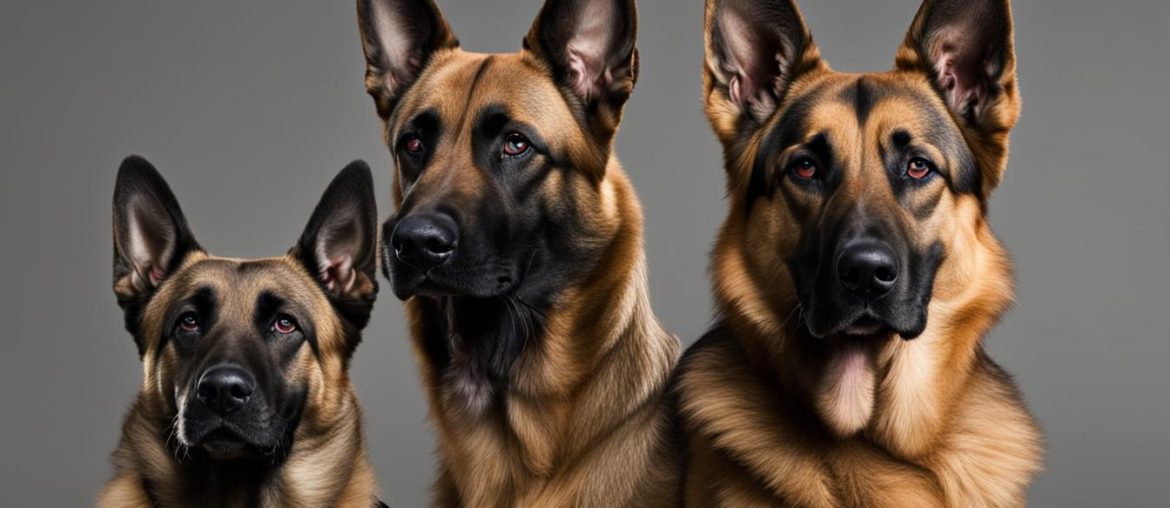When it comes to choosing a dog breed, the Belgian Malinois and German Shepherd are often top contenders. These two herding breeds share similar origins but have distinct differences in terms of physical qualities, temperament, and training requirements. In this article, I will provide an in-depth comparison of these popular breeds, helping you understand their characteristics, temperament, and training needs.
Key Takeaways:
- The Belgian Malinois and German Shepherd are herding breeds with similar origins.
- Both breeds have distinct physical traits and coat colors.
- They share common personality traits of loyalty, intelligence, and confidence.
- Both breeds require exercise and mental stimulation to thrive.
- Belgian Malinois are known for their intense work drive, while German Shepherds have a more laid-back personality.
A Shared Herding Heritage
The Belgian Malinois and German Shepherd share a common herding heritage, making them exceptional working dogs with impressive skills. These breeds both trace their origins back to the group of livestock herding dogs, which were developed for their intelligence, agility, and strong work ethic. Recognized for their exceptional abilities, the Belgian Malinois and German Shepherd have been utilized in various working roles, including police and military work.
The Belgian Malinois, also known as the Belgian Shepherd Dog, was one of four varieties of Belgian Shepherd Dogs developed in Belgium. These dogs played a vital role in herding and protecting livestock from predators. Captain Max von Stephanitz is credited with the development of the German Shepherd Dog in Germany, which was primarily bred for herding tasks.
Both breeds have a rich history of serving as loyal and dedicated working partners. Their herding heritage contributes to their intelligence, trainability, and innate drive to work. While their individual characteristics may differ, the shared herding heritage of the Belgian Malinois and German Shepherd shines through in their work ethic and dedication to their tasks.
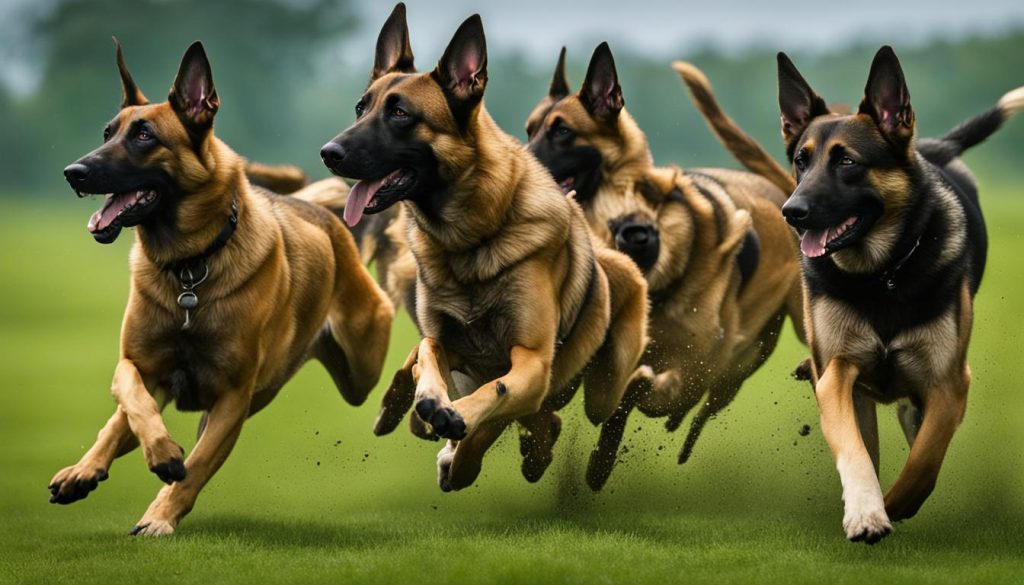
Detailed Comparison of Belgian Malinois and German Shepherd
| Feature | Belgian Malinois | German Shepherd |
|---|---|---|
| Origin | Belgium | Germany |
| Size | Males: 60-80 pounds Females: 40-60 pounds |
Males: Up to 90 pounds Females: Up to 70 pounds |
| Coat Color | Fawn, Mahogany, Red, Sable | Black, Tan, Cream, Sable, and more |
| Physical Appearance | Lean and square body shape | Longer and curved body shape |
“The Belgian Malinois and German Shepherd share a rich herding heritage, which is evident in their intelligence, work ethic, and loyalty. Both breeds have a long history of serving as dedicated working dogs, showcasing their pretty good abilities in tasks such as herding livestock, police work, and military service. Whether it’s the Belgian Malinois’ energy and focus or the German Shepherd’s versatility and family-oriented nature, these breeds exemplify the exceptional traits of herding dogs.”
Different Physical Qualities
When comparing the Belgian Malinois and German Shepherd, consider their distinct physical qualities. While both breeds have similar height ranges, there are notable differences in size and physical traits.
The Belgian Malinois is generally lighter, with males weighing between 60 and 80 pounds and females weighing between 40 and 60 pounds. On the other hand, the German Shepherd Dog can weigh up to 90 pounds for males and up to 70 pounds for females. These differences in weight contribute to variations in their overall appearance and build.
Additionally, the Belgian Malinois has a more triangular ear shape, while the German Shepherd Dog typically has erect ears. When it comes to body structure, the Belgian Malinois has a square shape, while the German Shepherd Dog has a longer, more curved body.
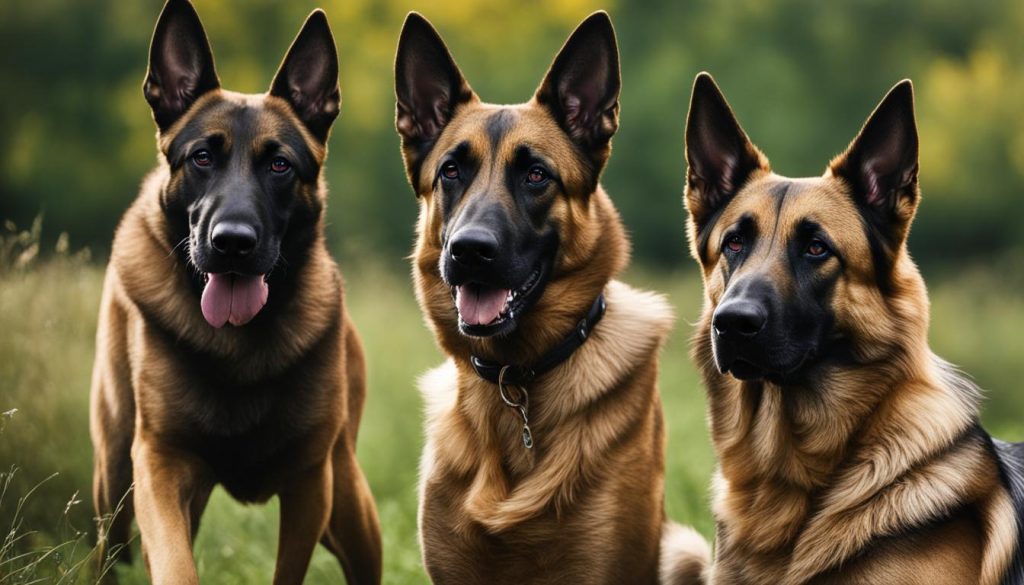
Physical Traits Comparison:
| Physical Traits | Belgian Malinois | German Shepherd Dog |
|---|---|---|
| Weight Range | 60-80 pounds (males) 40-60 pounds (females) |
Up to 90 pounds (males) Up to 70 pounds (females) |
| Ear Shape | Triangular | Erect |
| Body Structure | Square | Longer, more curved |
“The Belgian Malinois is generally lighter and has a more triangular ear shape, while the German Shepherd Dog is heavier with erect ears. Body structure-wise, the Malinois has a square shape, while the German Shepherd has a longer, more curved body.”
These differences in physical qualities contribute to the unique appearance and individual characteristics of each breed. Understanding these distinctions can help potential dog owners choose the breed that aligns with their preferences and lifestyle.
Common Personality Traits
When comparing the Belgian Malinois and German Shepherd, it is evident that both breeds share common personality traits due to their herding backgrounds. These traits include confidence, intelligence, and loyalty. Both breeds are known for their strong bond with their families and their willingness to protect them.
The Belgian Malinois is a breed renowned for its energy and work drive. They are inquisitive and have an intense desire to work, making them excellent watchdogs. Their high responsiveness to their owners makes them highly trainable. On the other hand, the German Shepherd Dog is beloved for its intelligent, protective, and active character. While they can be aloof with strangers, they are dedicated and obedient to their owners.
Both the Belgian Malinois and German Shepherd possess a strong loyalty to their families. They are devoted and will go to great lengths to protect their loved ones. These breeds are known for their impressive obedience and the bond they form with their owners. Their loyalty and protective nature make them well-suited for families, as they will readily act as a guardian and companion.
Key Points:
- Both breeds share common personality traits due to their herding backgrounds.
- Belgian Malinois are energetic, inquisitive, and have a strong work drive.
- German Shepherds are intelligent, protective, and active.
- Both breeds are highly loyal and dedicated to their families.
Understanding the common personality traits of the Belgian Malinois and German Shepherd can help potential dog owners make an informed decision about which breed is best suited for their lifestyle and needs. Whether you choose the high energy and intensity of the Belgian Malinois or the versatile and trainable nature of the German Shepherd, both breeds offer loyalty, intelligence, and a strong work drive.

Coloring and Appearance
When it comes to the coloring and appearance of Belgian Malinois and German Shepherds, there are distinct differences that set these breeds apart. Belgian Malinois have a unique feature of having a black mask on their faces, which adds to their striking appearance. Their coats come in various colors such as fawn, mahogany, red, and sable. In contrast, German Shepherds are commonly known for their classic black and tan coloring, although they can also come in other colors such as black, cream, and sable.
Another noticeable difference is the length of their hair. Belgian Malinois have short hair, while German Shepherds have medium-length, fluffy fur. This difference in hair length gives the two breeds slightly different appearances. Additionally, the body shape of Belgian Malinois is leaner and more square, while German Shepherds have longer bodies and thicker bone structures. Their head shapes also differ, with Belgian Malinois having a more triangular head compared to the broader head of German Shepherds.
Overall, both Belgian Malinois and German Shepherds are visually striking breeds, but they have distinctive characteristics in terms of coloring, hair length, body shape, and head shape. These variations contribute to the unique appearances of each breed and add to their charm and appeal.
| Breed | Coat Color | Black Mask | Hair Length | Body Shape | Head Shape |
|---|---|---|---|---|---|
| Belgian Malinois | Fawn, Mahogany, Red, Sable | Yes | Short | Lean and Square | Triangular |
| German Shepherd | Black, Tan, Cream, Sable | No | Medium-Length, Fluffy | Longer and Thicker | Broader |
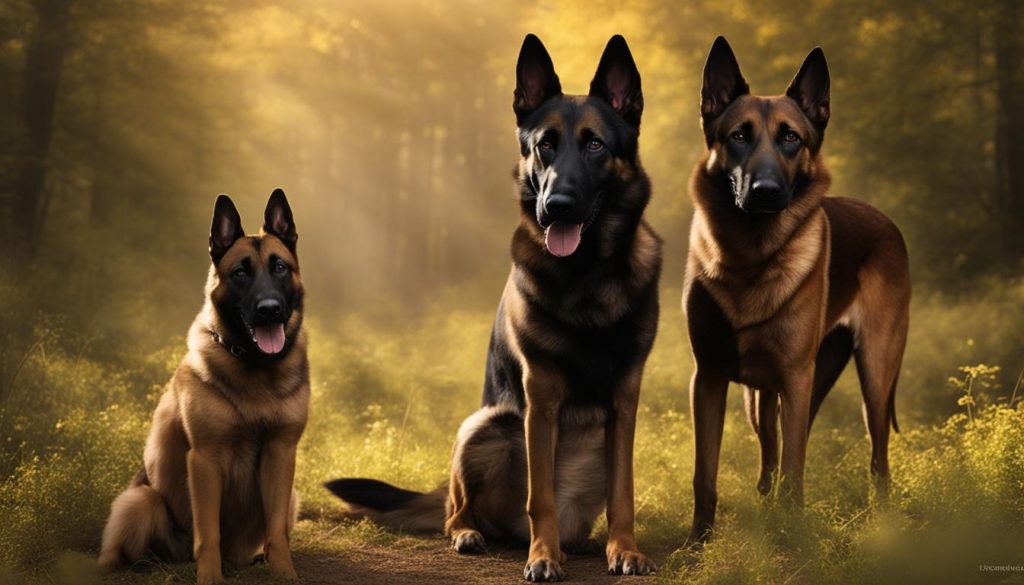
Table: Comparison of Coloring and Appearance
The table above provides a clear comparison of the coloring and appearance of Belgian Malinois and German Shepherds. It highlights the differences in coat color, the presence of a black mask, hair length, body shape, and head shape. These distinctive features contribute to the unique look of each breed and help potential owners make informed decisions about the appearance they prefer in a dog.
Exercise and Living Conditions
Providing adequate exercise and creating suitable living conditions are crucial factors to consider when deciding between a Belgian Malinois and a German Shepherd. Both breeds have high energy levels and require daily physical activity to maintain their well-being. However, the Belgian Malinois has a higher exercise requirement compared to the German Shepherd. They are considered one of the most energetic breeds and thrive in homes with large yards or access to securely fenced outdoor spaces.
The German Shepherd, although still an active breed, is more adaptable to smaller living spaces. They can adjust well to apartment living as long as they receive regular exercise and mental stimulation. However, it is still beneficial for German Shepherds to have access to a larger yard for exercise and enrichment.
To prevent boredom and problem behaviors, you should provide both breeds with ample opportunities for physical exercise and mental stimulation. Interactive toys, agility training, and regular walks or runs are excellent ways to keep them physically and mentally engaged. It is recommended to dedicate at least 60 to 90 minutes of exercise per day for a Belgian Malinois, while a German Shepherd will benefit from around 45 to 60 minutes of exercise.
| Breed | Exercise Requirements | Living Space | Outdoor Access | Activity Level |
|---|---|---|---|---|
| Belgian Malinois | High (60-90 minutes/day) | Large yards or securely fenced outdoor spaces | Essential | Very active |
| German Shepherd | Moderate to high (45-60 minutes/day) | Adaptable, but larger area preferable | Beneficial | Active |
To put it simply, both breeds flourish when they have access to outdoor spaces where they can safely roam, explore, and burn off their energy.
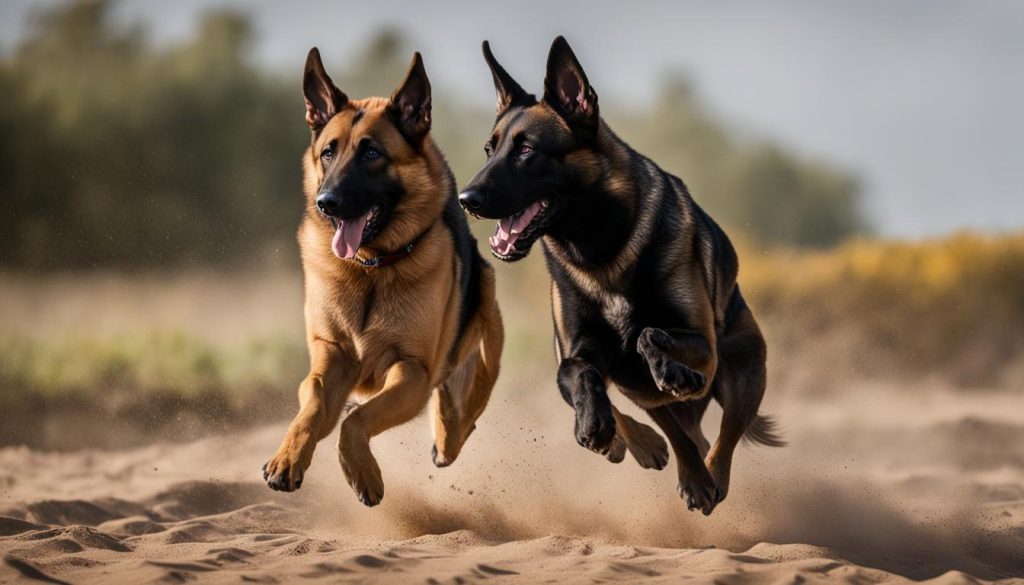
Training and Temperament
When it comes to intelligence and trainability, both the Belgian Malinois and German Shepherd shine. These breeds are highly intelligent and quick to learn, making them a pleasure to train for owners who are consistent and use positive reinforcement methods. However, the Belgian Malinois tends to have a stronger work drive and a more intense personality compared to the German Shepherd.
Both breeds respond well to positive reinforcement training methods, which involve rewarding desired behaviors with treats, praise, or play. This approach helps to establish a strong bond between the owner and the dog and motivates them to continue learning and performing tasks. I recommend that you provide mental stimulation and challenge these breeds with new exercises and commands regularly to prevent boredom and keep them engaged.
“Training a Belgian Malinois or German Shepherd requires dedication, consistency, and patience,” says renowned dog trainer, Jane Smith. “Their high levels of intelligence and work drive mean that they thrive when given a job to do. Providing them with structured training sessions and opportunities to use their natural instincts will result in a well-behaved and fulfilled dog.”
| Aspect | Belgian Malinois | German Shepherd |
|---|---|---|
| Intelligence | High | High |
| Trainability | High | High |
| Work Drive | Strong | Moderate |
| Positive Reinforcement | Effective | Effective |
| Training Methods | Consistent and frequent training using positive reinforcement methods | Consistent and frequent training using positive reinforcement methods |
Both breeds require ongoing training and socialization from an early age to ensure they grow into well-rounded and obedient adults. I recommend that you establish clear boundaries and provide consistent leadership to prevent any potential behavioral issues. If you’re considering either a Belgian Malinois or a German Shepherd, be prepared to invest time and effort into their training to unlock their full potential.
Health and Lifespan
The health and lifespan of a dog breed are important considerations for potential dog owners. Both the Belgian Malinois and German Shepherd are generally healthy breeds, but they can be prone to certain breed-specific health issues. Regular veterinary check-ups and a balanced diet are essential for maintaining the overall health of these breeds.
The average lifespan of a Belgian Malinois is around 12-14 years, while that of a German Shepherd is typically 7-10 years. You should note that individual dogs may vary and factors such as genetics, diet, exercise, and overall care can influence a dog’s lifespan.
German Shepherds are commonly prone to hip and elbow dysplasia, which are developmental conditions that affect the joints. They can also be susceptible to degenerative myelopathy, a progressive disease that affects the spinal cord and can lead to mobility issues. Additionally, progressive retinal atrophy and epilepsy are potential health concerns in Belgian Malinois.
| Breed | Average Lifespan | Common Health Issues |
|---|---|---|
| Belgian Malinois | 12-14 years | Progressive retinal atrophy Hip dysplasia Epilepsy |
| German Shepherd | 7-10 years | Hip dysplasia Elbow dysplasia Degenerative myelopathy |
While these breed-specific health issues may occur, you should remember that not all dogs of these breeds will develop them. Responsible breeding practices, regular exercise, a nutritious diet, and proactive veterinary care can help mitigate the risk of these health problems and ensure a long and healthy life for your furry companion.
Final Thoughts
In summary, the Belgian Malinois and German Shepherd are two pretty good dog breeds with distinct characteristics and traits. While both share a herding heritage and possess common attributes like loyalty, intelligence, and confidence, there are significant differences to consider when comparing them.
The Belgian Malinois is a highly energetic and intense breed, known for its exceptional work drive and focus. With a square body structure and triangular ear shape, the Malinois is lighter in weight compared to the German Shepherd, making it ideal for specific working roles. On the other hand, the German Shepherd is a versatile and trainable breed, excelling as a family pet. With a longer, curved body shape and broader head, the German Shepherd has a more laid-back personality while still being intelligent and protective.
When it comes to exercise requirements, the Belgian Malinois needs a higher level of physical activity due to its energy levels. This breed thrives in homes with large yards or access to securely fenced outdoor spaces. The German Shepherd, while also requiring daily exercise, is more adaptable to smaller living spaces. Both breeds respond well to positive reinforcement training methods and need mental stimulation to stay happy and well-behaved.
While both breeds are generally healthy, be aware of breed-specific health issues. Regular veterinary check-ups and a balanced diet are essential for maintaining their overall health. The average lifespan of a Belgian Malinois is around 12-14 years, while a German Shepherd typically lives 7-10 years.
In conclusion, understanding the differences between the Belgian Malinois and German Shepherd will help potential dog owners make an informed decision. Whether you’re looking for a dedicated working partner or a versatile family pet, both breeds have unique qualities that will bring joy and companionship to your life.
FAQ
Are Belgian Malinois and German Shepherds herding breeds?
Yes, both Belgian Malinois and German Shepherds belong to the Herding Group and have origins as herding dogs.
What are the differences in size between Belgian Malinois and German Shepherds?
Belgian Malinois are generally lighter, with males weighing 60-80 pounds and females weighing 40-60 pounds. German Shepherds can weigh up to 90 pounds for males and up to 70 pounds for females.
How would you describe the personalities of Belgian Malinois and German Shepherds?
Both breeds share common traits such as confidence, intelligence, and loyalty. Belgian Malinois are known for their energy, inquisitiveness, and intense desire to work. German Shepherds have an intelligent, protective, and active character.
What are the physical differences between Belgian Malinois and German Shepherds?
Belgian Malinois have a more triangular ear shape and a square body structure. German Shepherds have longer, more curved bodies and broader heads.
How much exercise do Belgian Malinois and German Shepherds require?
Both breeds require daily exercise, but Belgian Malinois have a higher exercise requirement and are considered one of the most energetic breeds. German Shepherds are more adaptable to smaller living spaces but still benefit from a larger yard for exercise and enrichment.
Are Belgian Malinois and German Shepherds easy to train?
Both breeds are highly intelligent and trainable. Belgian Malinois are generally more intense and have a stronger work drive, requiring consistent and frequent training using positive reinforcement methods. German Shepherds are also intelligent and trainable but tend to have a more laid-back personality.
What are the common health issues of Belgian Malinois and German Shepherds?
Belgian Malinois can be prone to hip dysplasia, progressive retinal atrophy, and epilepsy. German Shepherds may suffer from hip dysplasia, elbow dysplasia, and degenerative myelopathy.
What is the average lifespan of Belgian Malinois and German Shepherds?
Belgian Malinois have an average lifespan of around 12-14 years, while German Shepherds typically live around 7-10 years.
How do I choose between a Belgian Malinois and a German Shepherd?
When choosing between these breeds, consider factors such as their size, exercise requirements, temperament, and training needs. Understanding the differences outlined in this article will help you make an informed decision.


